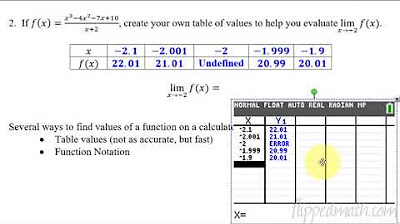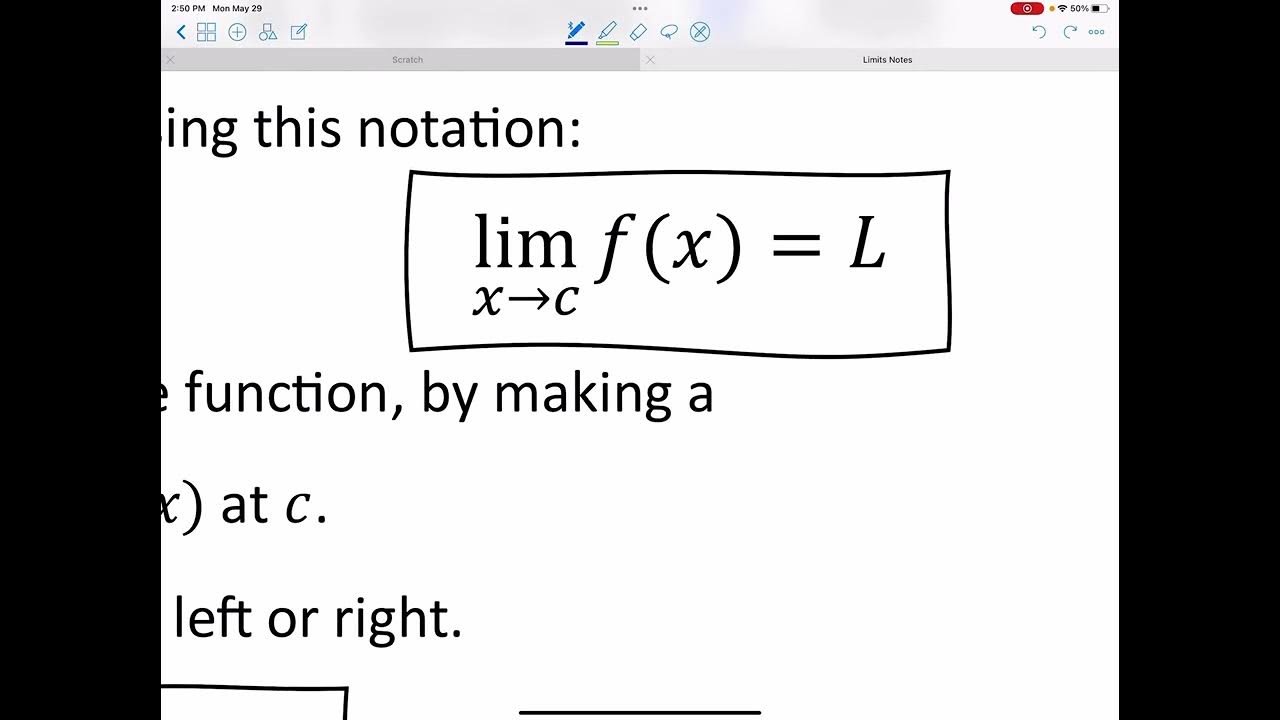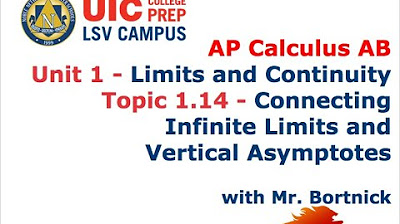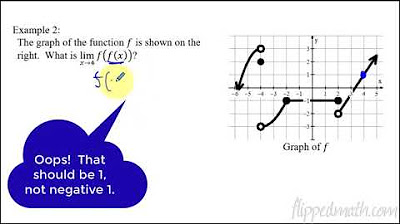AP Calculus AB - 1.4 Estimating Limit Values from Tables
TLDRIn this AP Calculus AB lesson, Mr. Bortnick focuses on estimating limit values from tables in Unit 1.4. He introduces graphical and tabular methods to approximate limits, emphasizing the importance of using a calculator for precise estimation. The instructor demonstrates calculator tricks for evaluating limits as x approaches specific values, highlighting the need for rounding to three decimal places. The lesson concludes with practical examples, including the cosine of a function, reinforcing the connection between different mathematical representations.
Takeaways
- 📚 The lesson is part of an AP Calculus AB course, focusing on Unit 1: Limits and Continuity, specifically Topic 1.4 - Estimating Limit Values from Tables.
- 🔍 A graphing calculator or online graphing calculator is required for this lesson to perform specific calculations and visualize functions.
- 📈 The lesson explains how to estimate limits from both graphical and tabular data, emphasizing the importance of looking at values from both the left and right sides of the point of interest.
- 📝 The instructor demonstrates how to interpret a table of values to approximate the limit of a function as 'x' approaches a certain value, highlighting that this is an estimate without the actual function.
- 📉 The video script includes a step-by-step guide on how to use a graphing calculator to find limit values, including a 'table set' trick for more precise control over the x-values.
- 👨🏫 The teacher provides a calculator trick for function notation on a TI-84 Plus CE calculator, showing how to input equations and retrieve function values for specific x-values.
- 📑 The script walks through the process of filling out a table of values to evaluate the limit of a function as 'x' approaches a certain point, using both the table function and function notation on the calculator.
- 🤔 The importance of rounding to three decimal places in AP Calculus is stressed, as it is a standard requirement on the AP exam and in the course.
- 📚 The lesson also covers how to handle cases where the function is undefined at a certain point, such as division by zero, and how to work around this when estimating limits.
- 🔢 A practical example is given where the limit of a function as 'x' approaches -2 is calculated, using both the table of values and function notation on the calculator to estimate the limit.
- 🔄 The final part of the script discusses the continuity and increasing nature of a function for 'x' greater than or equal to 1, and how to approximate the limit of the cosine of the function as 'x' approaches 2, including the use of radian mode on the calculator.
Q & A
What is the main topic of Mr. Bortnick's lesson?
-The main topic of Mr. Bortnick's lesson is estimating limit values from tables in the context of AP Calculus AB, specifically in Unit 1 Limits and Continuity, Topic 1.4.
Why is a calculator necessary for this lesson?
-A calculator is necessary for this lesson because it is required to find limits from tables and to perform specific calculator tricks that are useful for estimating limit values.
What is a graphical interpretation of finding a limit?
-A graphical interpretation of finding a limit is visually identifying the value of the limit as x approaches a certain point by observing the behavior of the function around that point on a graph.
How does the table of values help in estimating a limit?
-The table of values helps in estimating a limit by showing the y-values as x-values approach a certain point from both the left and right sides, allowing students to see how close the y-values get to a particular number, which is the estimated limit.
What is the difference between an estimate and the actual limit?
-An estimate of a limit is an approximation based on the values given in a table or observed graphically, while the actual limit is the precise value the function approaches at a certain point, which can only be determined with the function's formula.
How should the x-values be chosen when creating a table to estimate a limit?
-When creating a table to estimate a limit, the x-values should be chosen very close to the point at which the limit is being approached, with values both slightly above and below this point to observe the behavior from both sides.
What is the importance of rounding to three decimal places in AP Calculus?
-Rounding to three decimal places is important in AP Calculus because it is a standard requirement on the AP exam, ensuring a consistent level of precision in calculations and answers.
What is a 'table set' in the context of using a graphing calculator?
-A 'table set' is a feature on a graphing calculator that allows the user to customize the table settings, such as the starting value, the increment, and the specific x-values at which to evaluate the function, providing more control over the table of values.
How can function notation be used on a calculator to find function values?
-Function notation on a calculator allows the user to store an equation in a variable, such as Y1, and then input specific x-values to find the corresponding y-values, simulating the process of evaluating a function at different points.
Why should a calculator be in radian mode for AP Calculus?
-A calculator should be in radian mode for AP Calculus because the AP exam and the course itself use radians as the standard unit for trigonometric functions, ensuring consistency and accuracy in calculations.
What is the significance of the cosine function in the context of the third problem discussed in the script?
-In the context of the third problem, the significance of the cosine function is to determine the limit of the cosine of f(x) as x approaches a certain value, given that f(x) is approaching a specific number, which in this case is 5.
Outlines
📚 Estimating Limit Values from Tables
In this segment, Mr. Bortnick delves into the topic of estimating limit values from tables within the realm of AP Calculus AB. He introduces the lesson on finding limits from tables and emphasizes the importance of using a graphing calculator or an online graphing calculator for this section. The instructor provides a step-by-step guide on how to interpret graphical and tabular data to estimate limits, using the function f(x) as an example. He visually demonstrates that the limit as x approaches 3 of f(x) is four, both from a graphical and a tabular perspective. The lesson also touches on the importance of understanding different mathematical representations, such as graphical, tabular, and algebraic, which are all interconnected and will be further explored in future lessons.
🔍 Advanced Calculator Techniques for Limits
This paragraph focuses on employing advanced calculator techniques to evaluate limits, specifically when dealing with functions that may result in undefined values at certain points. Mr. Bortnick demonstrates how to input equations into a TI-84 Plus CE calculator and create a table of values to approximate limits. He highlights a 'table set' feature that allows for the input of non-integer x-values, which is crucial for estimating limits as x approaches values that make the function undefined, such as negative two in the provided example. The instructor also introduces function notation on the calculator to obtain more precise values and decimal places, which is particularly useful for closer approximations of limits.
📉 Understanding Continuity and Increasing Functions
In this part of the lesson, the concept of continuity and increasing functions is explored. The instructor discusses how to use a table of values for a function that is continuous and increasing for x greater than or equal to one. He explains the process of selecting x-values close to the point of interest (x=2 in this case) to approximate the limit of the cosine of the function as x approaches two. The approach involves observing the values from both sides of the point and inferring the limit based on the trend of the values. The instructor also provides a calculator tip, emphasizing the importance of using radian mode for accurate trigonometric calculations in AP Calculus.
📝 Completing Tables and Estimating Limits
The instructor wraps up the lesson by guiding students through the process of creating their own table of values to evaluate the limit of a function as x approaches a specific value. He advises on the selection of x-values that are very close to the point of interest to ensure a more accurate approximation of the limit. Mr. Bortnick also discusses the importance of rounding to three decimal places in AP Calculus, as it is a standard requirement for the AP exam. The lesson concludes with a reminder to practice the problems and to seek clarification for any doubts, fostering an environment of continuous learning and improvement.
🧭 Calculator Tips and Final Notes
In the final paragraph, Mr. Bortnick provides additional calculator tips, specifically for the AP Calculus exam, where the calculator should always be in radian mode. He demonstrates how to calculate the cosine of a value using the calculator and explains the process of rounding the result to three decimal places, which is a requirement for the exam. The instructor encourages students to practice the problems provided and to come to class with any questions they may have, emphasizing the importance of understanding the material and being prepared to ask for help when needed.
Mindmap
Keywords
💡AP Calculus AB
💡Limits
💡Continuity
💡Graphical Interpretation
💡Table of Values
💡Estimating Limit Values
💡Calculator Tricks
💡Function Notation
💡Radian Mode
💡Truncating and Rounding
💡Increasing Function
Highlights
Introduction to the lesson on estimating limit values from tables in AP Calculus AB Unit 1.
Requirement of a graphing calculator or access to an online graphing calculator for the lesson.
Explanation of specific calculator tricks to assist in estimating limits from tables.
Visual approach to estimating limits using a graph, demonstrated with an example limit as x approaches 3.
Different representations of math: graphical, tabular, and algebraic, with an emphasis on their connections.
The process of estimating a limit from a table of values, using the example of x approaching 3.
Estimation of limits as an approximation due to the lack of the actual function between certain values.
Demonstration of using a table to estimate the limit as x approaches -4, with the limit being approximately 2.5.
Instruction to create a table of values to evaluate the limit as x approaches -2 for a given function.
Use of a TI-84 calculator to input the function and create a table of values for estimating limits.
Explanation of the 'table set' feature on calculators to customize the table for limit estimation.
Alternative method using function notation on a calculator for more precise values and decimal places.
The importance of rounding to three decimal places in AP Calculus as per exam standards.
Application of the function notation method to estimate the limit as x approaches -2, resulting in a limit of 21.
Final task of estimating the limit of the cosine of f(x) as x approaches 2, given a table of f(x) values.
Use of calculator to find the cosine of the limit value, emphasizing the need for radian mode for AP Calculus.
Conclusion of the lesson with a reminder to practice problems and ask questions in the next class.
Transcripts
Browse More Related Video

Calculus AB/BC – 1.4 Estimating Limit Values from Tables

Limits

AP Calculus AB - 1.3 Estimating Limit Values From Graphs

AP Calculus AB - 1.9 Connecting Multiple Representations of Limits

AP Calculus AB - 1.14 Connecting Infinite Limits and Vertical Asymptotes

Calculus AB/BC – 1.5 Determining Limits Using Algebraic Properties
5.0 / 5 (0 votes)
Thanks for rating: